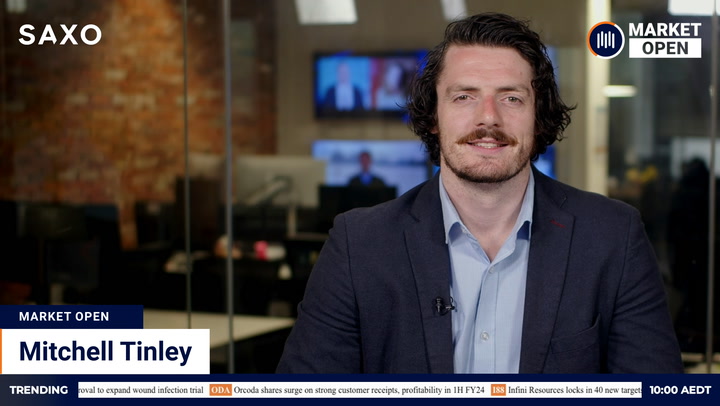A new reporting season looked set for a positive start as earnings optimism and start-of-month institutional buying outweigh negative leads from Wall Street.
ASX futures rallied 37 points or 0.51 per cent despite solids falls in the US and declines in key commodities.
Iron ore dived more than 7 per cent to its lowest level since April. Copper and gold declined. Oil edged higher.
The S&P/ASX 200 fell 25 points or 0.33 per cent on Friday as deep declines in US futures foreshadowed a challenging end to the US trading week.
Wall Street
US stocks ended a sixth straight winning month in retreat after a revenue miss from Amazon triggered declines in some of the pandemic’s biggest winners.
The S&P 500 retreated 24 points or 0.54 per cent. The Nasdaq Composite shed 106 points or 0.71 per cent. The Dow Jones Industrial Average dropped 149 points or 0.42 per cent.
Amazon skidded 7.56 per cent after second-quarter revenues missed Wall Street estimates and the company dampened expectations for this quarter. The online retail giant said it expected sales growth to slow as pandemic tailwinds ease. The reopening of the American economy meant people were spending less time indoors shopping.
Other winners from the stay-at-home economy felt the chill wind. Facebook dipped 0.56 per cent. Google parent company Alphabet fell 0.77 per cent. Pinterest slumped 18.24 per cent after losing users last quarter.
“Overall earnings have been good. But Amazon… and some of last year’s winners are taking some of the air out of the market,” Jake Dollarhide, chief executive officer of Longbow Asset Management, told Reuters. “This market has been driven by big tech and when tech does well, the market seems to go right along with it, and when it doesn’t,” it drops.
Declines were capped by slightly milder inflation data than economists expected. The personal consumption expenditures price index rose to 3.5 per cent in June from 3.4 per cent in May, below the 3.6 per consensus. Core prices increased by 0.4 per cent from the previous month. Economists polled by Dow Jones expected an increase of 0.6 per cent.
The major indices recorded their sixth straight month of gains. The S&P 500 put on 2.3 per cent, the Dow 1.3 per cent and the Nasdaq 1.2 per cent.
“There has been quite a bit of volatility and price choppiness in the market in recent weeks,” Brian Belski, chief investment strategist at BMO, told clients. “Increased concerns over the delta variant and its potential implications for reopening momentum seemed to play a key role in the price action, while peak themes related to economic growth, earnings, and policy support also remained an overhang on risk sentiment.”
Australian outlook
A positive start coming up for the ASX as institutional traders position for what is expected to be a bumper profit season of increased dividend pay-outs. The S&P/ASX 200 looked set to reverse Friday’s 25-point reversal, which came in anticipation of Amazon earnings-fuelled falls in Wall Street. In the event, the damage in the US was much milder than US futures implied at the close of ASX trading on Friday.
Part of the reason for this morning’s upbeat futures outlook is likely expectations for a month of strong profit reports, plus optimism over tomorrow’s Reserve Bank policy update. The RBA is expected to reverse a decision to wind back its bond-buying program, extending support for the economy until at least next year. The Greater Sydney lockdown has changed the narrative by tipping the economy into reverse, forcing a rethink. Economists from the major banks now expect GDP to shrink up to 2.7 per cent this quarter.
The rest of the week’s economic reports are expected to reflect the impact of the lockdown. A busy schedule includes: job ads, manufacturing, house prices (today); building approvals (Tuesday); retail sales, vehicle sales, construction (Wednesday); trade data (Thursday); and services sector activity, House of Representatives testimony from RBA Governor Philip Lowe and a quarterly monetary policy update from the central bank (Friday).
The corporate reporting season does not fully hit its stride until the second half of the month, but this week brings a few early birds. Commercial property owner BWP Trust, which leases Bunnings Warehouses to Wesfarmers, reports full-year earnings on Wednesday. Mortgage insurer Genworth reports half-year earnings the same day.
News Corp reports fourth-quarter and full-year earnings on Thursday. Sleep apnea specialist ResMed has been making new highs ahead of a quarterly update the same day.
Online property ad firm REA Group reports full-year earnings on Friday. Lithium miner Galaxy Resources holds its AGM.
The rush to list in recent months seems to have exhausted much of the pent-up demand. The ASX lists just two initial public offerings this week: Perth-based Kimberly iron ore explorer Pantera Minerals (Thursday) and US-focused gold explorer Gold 50 (Friday).
The economic implications of the Greater Sydney lockdown have kept the dollar in a trading range between 73 and 74 US cents in recent weeks. The Aussie started the week in the lower half of the range, down 0.04 per cent at 73.35 US cents.
Commodities
Chinese efforts to depress the price of iron ore finally seemed to take effect last week following a clampdown on steel production. The spot price for ore landed in China skidded US$14.50 or 7.4 per cent to US$180.50 a tonne on Friday. The fall extended ore’s loss for the week to US$21.40 or 10.6 per cent.
“Prices fell as iron ore demand weakens in the face of policy to reduce China’s steel output as a means to cut emissions,” CBA commodities analyst Vivek Dhar said.
China has reportedly asked steelmakers to cap this year’s production at last year’s output. A 12 per cent increase in first-half production means a sharp contraction in the second half would be necessary to meet government expectations.
Australian ore giants BHP and Rio Tinto hit all-time highs last week on the back of record production and strong prices. BHP’s US-listed stock shed 2.09 per cent on Friday. Its UK-listed stock fell 1.94 per cent. Rio Tinto gave up 2.66 per cent in the US and 2.94 per cent in the UK.
Oil rose for a fourth month, supported by signs of tightening US supplies. Brent crude settled 31 US cents or 0.4 per cent ahead at US$75.41 a barrel. Brent gained around 3 per cent for the week and 1.6 per cent for the month.
Gold retreated from a six-week high. Metal for August delivery settled US$18.60 or 1 per cent weaker at US$1,817.20 an ounce. The NYSE Arca Gold Bugs Index dipped 0.42 per cent.
“Gold held onto its post-Fed gains but appears to have met resistance around $1,830…If the dollar’s losses deepen in the coming days and Treasury yields remain subdued, the prospect for a break above this resistance is strong,” Raffi Boyadjian, lead investment analyst at XM, wrote.
Copper declined 0.9 per cent to US$4.48 a pound on Comex. Prices gained 4.5 per cent for the month.
On the London Metal Exchange, benchmark copper dropped 1 per cent to US$9,701 a tonne. Aluminium eased 0.4 per cent, nickel 1.4 per cent and tin 0.3 per cent. Lead gained 0.6 per cent and zinc 1.2 per cent.







